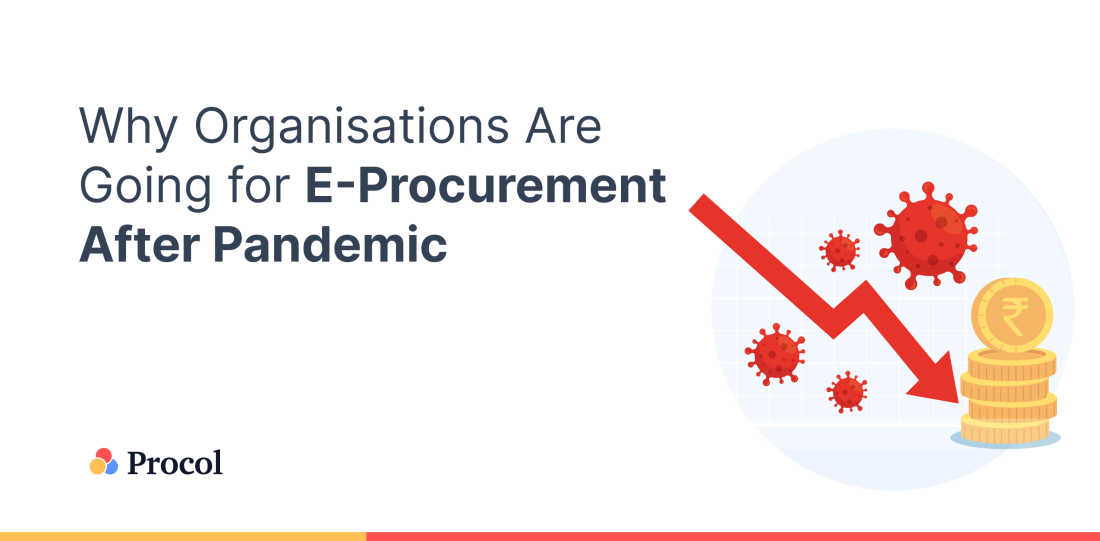Why Organisations Are Going for E-Procurement After Pandemic

TABLE OF CONTENTS
There has been a paradigm shift ever since the COVID-19 pandemic. Almost every business function witnessed major roadblock in the supply chain, and in a bid to adapt to the new normal, businesses saw a new way of handling operations. COVID-19 disrupted the entire supply chain leading to inventory imbalances, delayed deliveries, supply-demand disparity, and ultimately, a rise in prices.
While employees can work from home, procurement can’t! Therefore, it’s crucial for businesses to adapt to ongoing disruptions and revamp procurement functions. Organisations have become more proactive instead of reactive when it comes to their supply chain. Following are some noteworthy changes in the procurement operations:
Post-pandemic Era: Key Changes in the Procurement
1. Diversification of suppliers: Organisations have reduced their dependence on one or two suppliers as a result of pandemic-induced lockdowns and supply chain disruptions. To overcome delivery delays and operational malfunctions, organisations are now assessing the reliability and financial health of the suppliers to ensure uninterrupted supplies over the long run.
2. Rebalancing stocks: Stock-outs was a common scenario in the pandemic era. As the supply chain saw disruptions, the supply of critical materials halted. Since then, organisations have started developing and adopting strategies to ensure that the inventory is rebalanced, and stock-outs are prevented in the post-COVID-19 era. Timely requisitions and swift delivery have been some of the key drivers to ensure that the organisation has adequate stocks to meet the demand.
3. Changing customer demands: Analyzing and understanding the ever-changing customer demands are important for any organisation which directly affects the procurement function. Organisations need to be sure whether their supply base is fulfilling the demand of the customers and, if not, whether there is a need to upgrade or change the supply base.
4. Enhancing the visibility of the supply chain: The most effective way to track the supply chain function is to enhance its visibility which highlights the functioning and possible hurdles in the organizational supply chain. Improving the visibility of the supply chain can significantly help in taking corrective steps and boost the efficiency.
5. Proactive approach: One of the key blessings in disguise of the pandemic is a shift towards a proactive approach rather than a reactive approach. With sudden lockdowns and supply shortages, procurement teams have identified a major gap in their operations and are working their way to be future-ready for more such natural catastrophes. Further, artificial intelligence and advanced analytic functions can also help procurement teams in improving their functioning.
- Enhancing supplier relationships: In the pandemic-driven world, supplier relations have been at the forefront to help businesses survive the adverse effects of the pandemic. While the procurement teams have always focused on building valuable relations with their suppliers, this pandemic has provided them with the opportunity to honour this relationship and thrive together in such difficult times. The contracts negotiated with the key suppliers are not just a procedural part, but a valuable asset for the organisation whose effects might seem intangible but have a lasting impact.
How Is Technology Paving the Way for Innovative Procurement Function?
Technology is revolutionising the way procurement functions. Real-time insights into the data have only enhanced the efficiency of the procurement function. Modern procurement software provides various analytic tools and solutions that help the procurement function understand the market response, timely orders and deliveries, crisis management as well as stay ahead of the competition. They further help analyse the demand and pricing trends while maintaining pricing and deliveries for key suppliers.
Another key benefit of using procurement software is the reduction of waste, particularly due to oversupply by the suppliers. This is a common phenomenon observed among businesses. The reduction of waste has immensely contributed to the reduction of costs of the organisation. Mentioned below are some features of smart procurement solutions:
- eRFX Solution: Save money and invaluable time with eRFX, which allows you to get more pricing options while keeping an eye on your travel costs.
- Contract Management: Make your entire contract management paperless while storing all the data in a centralised dashboard.
- Supplier Management: Improve supplier relationships and onboarding/deboarding with comprehensive supplier management solutions.
- Category Management: Category management allows you to seamlessly manage SKUs and product categories on the basis of fact-based, collaborative and rigorous analysis.
- Cost Optimisation: Cost optimisation is one of the most important functions of procurement which helps you to optimise your costs and leverage savings.
Conclusion
While there has been a disruption in the operations, ultimately, it only led to the improvement of the procurement function allowing organisations to act proactively and use Procol’s comprehensive procurement solutions to manage e-procurements smartly. With analytics, cost optimisation, integrations and many more features, Procol is revolutionising the way procurements happen in organisations. Are you still stuck in the old ways of procurement? If yes, then schedule a demo with Procol now!
Get a Free Demo
We'd love to hear from you. Please fill out this form to schedule a demo with us. You can also give a call on +91 76666 82222



